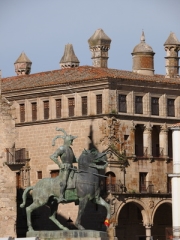Extremadura
Extremadura, the backwater that conquered America
Much of the culture, language, even the cuisine of South and
Central America originates in a few small towns in western Spain.
Extremadura, a dusty, sun-blasted region along the border with
Portugal, bred the Conquistadors, a ruthless and relentless band of
adventurers who carved out an empire across the Atlantic.
These days, Extremadura is more concerned with cuisine than
conquest. Visitors are drawn by the culinary traditions of
acorn-fed pigs and the resultant delicious hams and chorizo. Then
they discover the beautifully-preserved cities of Trujillo, Cáceres
and Mérida, in this evocative region of Spain.

Statue of Spanish conquistador
Francisco Pizarro in Trujillo
Trujillo in the afternoon seems like a sleepy, peaceful kind of
place, with the sun beating down on atmospheric medieval squares.
It's difficult to believe that its streets bred some of history's
cruellest warriors. A restless bunch of 15th-century Trujillo men
put the town on the map, driven by religious fervour or desire for
wealth, and led by the talented buccaneer Francisco Pizarro (who
tended to put gold before God).
One telling example of Trujillo's influence is the word "chico",
used by locals to mean small. It's a usage rarely heard elsewhere
in Spain, but a common expression in South America.
Pizarro built the lavish Palacio de la Conquista, on the corner
of the Plaza Mayor, as a gift for his half-brother Hernando, who
also became his son-in-law after he married Pizarro's half-Inca
daughter. To see how far the family ascended, visit the Pizarro
museum in his humble birthplace in the heart of the old town.
The old city of Cáceres (in the Province of Cáceres) now a World Heritage site, has a
marginally less bloody history. Its stone medieval centre takes on
a timeless quality when the day-trippers have departed, the shadows
lengthen, and the storks' nests are silhouetted against the
Extremadura sky. The Moors built the curved outer walls. Locals who
returned to the city from the Americas spent their gold on graceful
townhouses (known as solares). Otherwise Cáceres is
characterised by tough stone fortifications, solid dwellings
letting in only chinks of light.
Visitors with a reverence for the Aztecs might like to pay their
respects at the Casa De Toledo-Montezuma, once the residence of the
last Aztec emperor's daughter, brought to Cáceres by one of Hernan
Cortes's sidekicks.
The identity of Extremadura, as a frontier region with a thirst
for overseas booty, is moulded by two cataclysmic events: the
occupation by the Moors and the conquest of the Americas. The
region had a certain importance long before that though, as an
outpost of the Roman Empire.
The Roman remains at Mérida are among the most significant in
Europe. There are the ruins of a Circus, a Forum, an Amphitheatre
and several substantial villas, as well as a bridge over the river
Guadiana, the longest of all surviving Roman bridges.
Seeing all the sights can be exhausting so it's better to spread
the visit over a couple of days, to do justice to the ruins and
mosaics. That also allows plenty of time to enjoy Mérida's
restaurants. You'll be amazed at the innumerable dishes on offer
involving some part of that beloved pig.
Provinces of Extremadura
Cáceres | Badajoz
